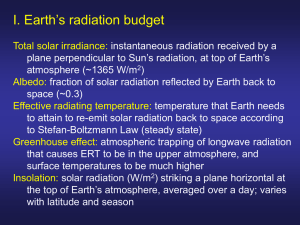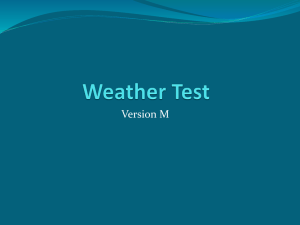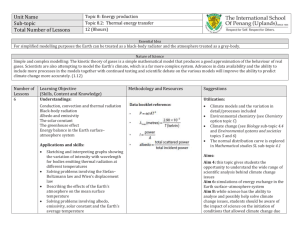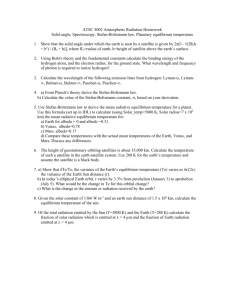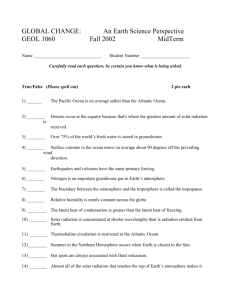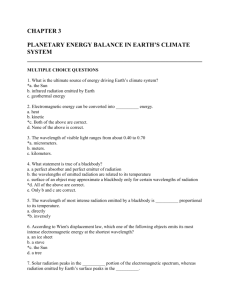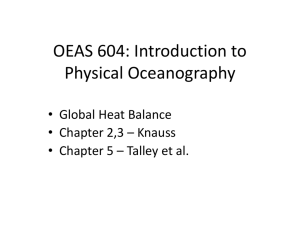Geog312-pre-test_survey
advertisement
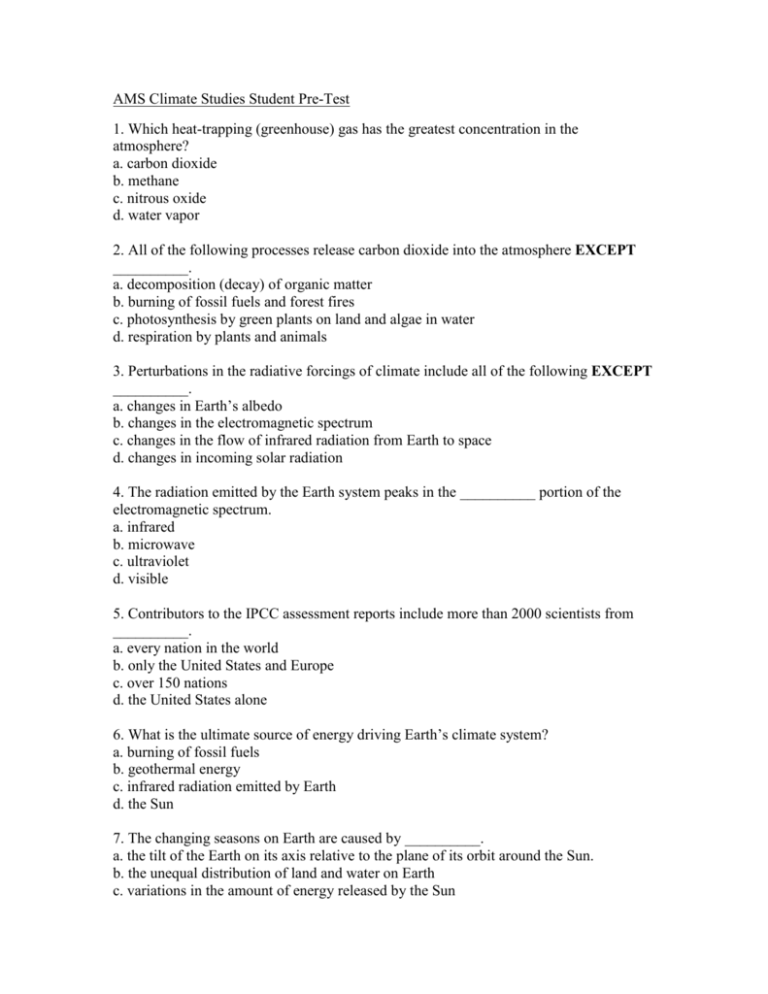
AMS Climate Studies Student Pre-Test 1. Which heat-trapping (greenhouse) gas has the greatest concentration in the atmosphere? a. carbon dioxide b. methane c. nitrous oxide d. water vapor 2. All of the following processes release carbon dioxide into the atmosphere EXCEPT __________. a. decomposition (decay) of organic matter b. burning of fossil fuels and forest fires c. photosynthesis by green plants on land and algae in water d. respiration by plants and animals 3. Perturbations in the radiative forcings of climate include all of the following EXCEPT __________. a. changes in Earth’s albedo b. changes in the electromagnetic spectrum c. changes in the flow of infrared radiation from Earth to space d. changes in incoming solar radiation 4. The radiation emitted by the Earth system peaks in the __________ portion of the electromagnetic spectrum. a. infrared b. microwave c. ultraviolet d. visible 5. Contributors to the IPCC assessment reports include more than 2000 scientists from __________. a. every nation in the world b. only the United States and Europe c. over 150 nations d. the United States alone 6. What is the ultimate source of energy driving Earth’s climate system? a. burning of fossil fuels b. geothermal energy c. infrared radiation emitted by Earth d. the Sun 7. The changing seasons on Earth are caused by __________. a. the tilt of the Earth on its axis relative to the plane of its orbit around the Sun. b. the unequal distribution of land and water on Earth c. variations in the amount of energy released by the Sun d. variations in the distance of the Earth to the Sun 8. The warmest climates on Earth are located near the tropics because this region __________. a. is much closer to the Sun b. reflects the greatest amount of incoming solar radiation c. receives the most hours of daylight d. receives the most nearly perpendicular incoming solar radiation 9. Which one of the following surfaces has the highest albedo for visible solar radiation? a. ocean water b. sand c. snow d. tropical rainforest 10. The major reason for the upward trend in atmospheric carbon dioxide since the mid1800s is __________. a. deforestation b. the burning of fossil fuels c. the ozone hole d. volcanic eruptions 11. Heat is transported from the Earth's surface into the troposphere via __________. a. convection b. evaporation c. radiation d. All of the above are correct. 12. Viewed from above in the Northern Hemisphere, surface winds about a center of high pressure blow __________. a. clockwise and inward b. clockwise and outward c. counterclockwise and inward d. counterclockwise and outward 13. In the Northern Hemisphere, currents flowing at the ocean’s surface along the East coast of major continents from lower latitudes would carry __________. a. cool water toward the north b. cool water toward the south c. warm water toward the north d. warm water toward the south 14. A monsoon climate typically features __________. a. wet summers and dry winters b. wet summer and winters c. dry summers and wet winters d. dry summer and winters 15. Which atmospheric conditions are most likely responsible for a sea breeze (wind blowing from the sea)? a. higher air pressure over the water and lower air pressure over the land b. higher air temperature over the water and lower air temperature over the land c. lower air density over the water and higher air density over the land d. lower visibility over the sea and higher visibility over the land 16. Through which process is some of the radiation striking an object converted to heat energy? a. absorption b. albedo c. reflection d. scattering 17. An strong and persistent El Niño __________. a. can be expected every year in mid-December b. involves an interaction between the tropical Atlantic ocean and atmosphere c. may be accompanied by weather extremes in various parts of the world d. seldom lasts longer than a few weeks 18. Plate tectonics has been an important control of climate __________. a. over the past 500 years b. over the past 10,000 years c. over the past 100,000 years d. throughout Earth’s history 19. Reliable instrumented temperature records date from the late a. 1500s b. 1600s c. 1700s d. 1800s 20. Hurricanes do not form at the equator because a. fronts are present. b. sea-surface temperatures typically are too low. c. there is no Coriolis Effect. d. upper-level winds are weak. 21. The definition of climate involves all of the following EXCEPT __________. a. averages of temperature and precipitation over the past 30 years b. boundary conditions and forcings established by the Sun and Earth system c. extremes in weather events over the entire period of record d. the state of the atmosphere at some particular place and time 22. The climate record shows the time of transition between climatic episodes to be __________ the duration of the individual episodes. a. about the same as b. much longer than c. much shorter than d. sometimes much longer than and sometimes much shorter than 23. El Niño and La Niña are inter-annual variations in Earth’s climate system occurring in the a. Atlantic Ocean b. Arctic Ocean c. Pacific Ocean d. Southern Ocean 24. Multi-year Arctic ice cover and ice thickness __________ in the last quarter of the 20th century. a. decreased slightly b. decreased substantially c. increased slightly d. increased substantially 25. Milankovitch argued that regular changes in the Earth-Sun geometry explained the large-scale climatic fluctuations during the Pleistocene Ice Age primarily by __________. a. altering the aerosol content of the troposphere b. appreciably altering the total amount of solar energy received by the Earth system c. changing the latitudinal and seasonal distribution of incoming radiation d. increasing the planetary albedo 26. Explain the greenhouse effect and its relationship to global climate change. 27. Provide three examples of the role the ocean plays in Earth’s climate system. 28. Describe natural and anthropogenic (human) causes of climate change. 29. Describe the processes involved in the carbon cycle and the implications for climate. 30. How do scientists study past climates before humans kept records? How do scientists monitor the current climate system to make predictions?
